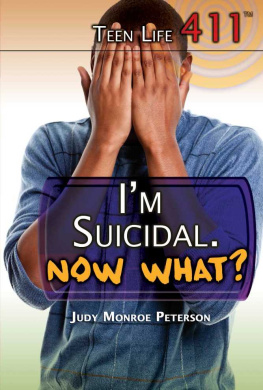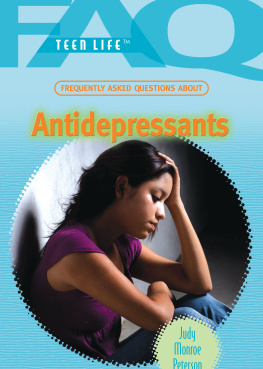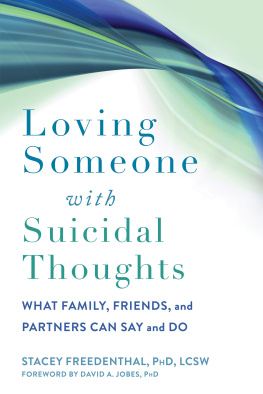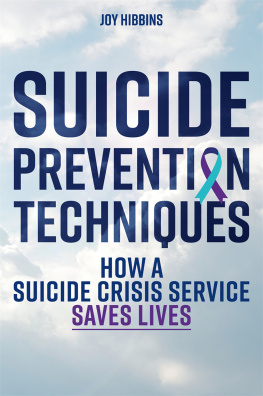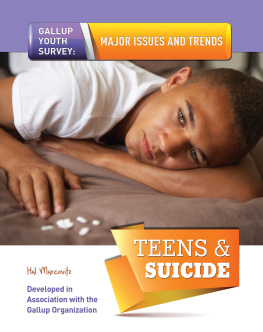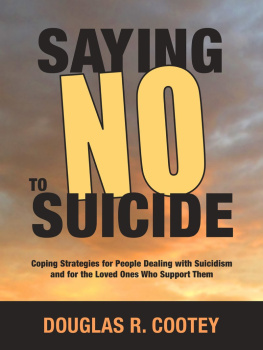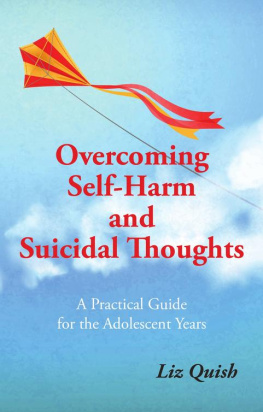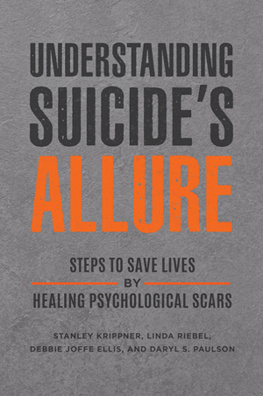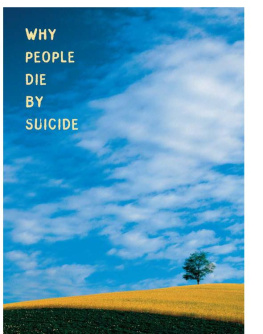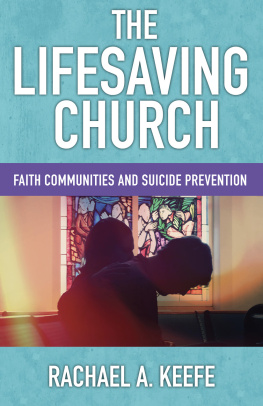Published in 2016 by The Rosen Publishing Group, Inc.
29 East 21st Street, New York, NY 10010
Copyright 2016 by The Rosen Publishing Group, Inc.
First Edition
All rights reserved. No part of this book may be reproduced in any form without permission in writing from the publisher, except by a reviewer.
Library of Congress Cataloging-in-Publication Data
Peterson, Judy Monroe.
Im suicidal, now what?/Judy Monroe Peterson.
pages cm. (Teen life 411)
Includes bibliographical references and index.
ISBN 978-1-4994-6136-7 (library bound)
1. TeenagersSuicidal behaviorJuvenile literature. 2. Suicidal behaviorJuvenile literature. 3. Suicide PreventionJuvenile literature. I. Title.
HV6546.P437 2016
362.28dc23
2014040283
Manufactured in the United States of America
For many of the images in this book, the people photographed are models. The depictions do not imply actual situations or events.
CONTENTS
INTRODUCTION
A t times, many people feel as though the world is pulling them down and they just cant cope. This feeling of being overwhelmed by lifes hurdles is especially common during the teen years, when new challenges, responsibilities, and pressures can pile up. Young people may also be facing problems with friends, at home or school, with bullying, or with an alcohol or drug addiction. In addition, difficult feelings might be complicated by a serious life event, including the separation or divorce of parents or the loss of a family member, friend, or even a beloved pet. Its no wonder that some individuals experience emotional overload, leading them to feel depressed, helpless, and hopeless.
If such distressing feelings continue over long periods of time, teens may feel isolated and separate themselves from everyone else. Some fall into deep despair and try drastic actions to escape their miseryincluding suicide, the act of intentionally taking ones own life. People who try to take their own lives usually do not want to die, but they see no alternatives to stop their endless mental and emotional suffering.
Suicide is found in every society. An enormous health problem, it ranks as one of the leading causes of death globally. The World Health Organization (WHO) reports that more than 800,000 people die from suicide every year, equaling about one death every forty seconds. Suicide is also a major concern in the United States. The Centers for Disease Control and Prevention (CDC) lists it as the tenth leading cause of death overall and the third leading cause of death for individuals aged ten to twenty-four. It is especially troubling that young people turn to suicide as the solution to their problems with alarming regularity. For every individual who dies by suicide, many others attempt it, and even more suffer the despair that leads them to even consider taking their own lives. Fortunately, it doesnt have to be this way.

Everyone needs help sometimes. Teens, who are navigating the challenging path between childhood and adulthood, should always feel free to ask for help, no matter how alone they feel or how hopeless things may seem. Depending on their situation, they can talk to a parent, a trusted adult or friend, a teacher, a school counselor, or a religious leader. Or they can turn to crisis hotlines to get immediate help. Health professionals often work with individuals who are suicidal to reduce their risk influences and strengthen factors that protect them. These protective features include healthy coping and problem-solving skills, learning to recognize and feel grateful for the positive aspects of their lives, improving family relationships, finding social support, and beginning psychotherapy or other mental health care options. Under proper medical care, prescription treatments such as antidepressants abate depression and actually eliminate suicidal thinking and behavior.
Though it may be difficult for young people to learn how to make the best of their circumstances and how to handle changesboth good and badthe excellent news is that with time, effort, and, if necessary, assistance, they can develop a healthy, positive state of mind and the skills to meet everyday challenges and demands. The vast majority of teens who were once in great emotional pain go on to live happy and healthy lives. They feel a sense of hope for today and what lies ahead by learning from the past and moving on to brighter, wiser, more grounded futures.
CHAPTER 1
UNDERSTANDING SUICIDE
S uicide is a choice made when sadness and despair combine with unclear thinking and the opportunity to take ones life. It is a decision that is final because the dead cannot come back to life. Unlike on a television show, when a character dies and then miraculously appears in another episode, real death is forever. Suicide is particularly tragic because it is preventable.
Threatening or attempting suicide is usually a plea for help. Troubled individuals may be signaling that they feel overwhelmed with unsolvable problems. Such behaviors often indicate that people have depression and can no longer handle their distressing feelings, thoughts, and stressful situations. They threaten or try to take their lives to end their great pain. Suicide, though, is never a good solution or end to any problem.
Major Global Public Health Problem
Suicide has been recorded for more than two thousand years. In modern times, many different types of individuals have taken their own lives, including children, teens, and adults. Suicide continues to be a critical issue for todays societies around the globe and can have lasting, harmful effects on families, friends, and communities. The WHO reports that more people die each year from suicide than from all murders and wars added together. To look at this horrific information another way, one individual somewhere in the world takes his or her life every forty seconds. The exact numbers may differ because many countries have little or no record keeping on suicide. These figures do not include suicide attempts, which occur much more frequently than suicide. According to the WHO, more than twenty people attempt to take their lives for every one adult who dies from the act of suicide.
The rates of suicide vary widely among different cultures and age groups. Sadly, the worldwide rates among teens and young adults have risen faster than those in any other age group. The WHO ranks suicide as the second leading cause of death for people ages ten to twenty-four.

To increase awareness of suicide, the WHO hosts a World SuicidePrevention Day (http://www.iasp.info/wspd) every September 10.Teens can participate in the Cycle Around the Globe event as well aslocal activities.
Serious Problem in the United States
Throughout recent history, suicide has been one of the leading causes of death in the United States. In 2011, the CDC tallied more than thirty-nine thousand suicides, making it the tenth leading cause of death for Americans. That figure translates into a staggering 107 deaths by suicide every day. Looking closely at the statistics for young people is frightening. For youth between the ages of ten and twenty-four, suicide is the third leading cause of death, resulting in approximately 4,600 lives lost each year. Currently, the American Association of Suicidology estimates that someone under the age of twenty-five completes a suicide every two hours somewhere in the nation.

